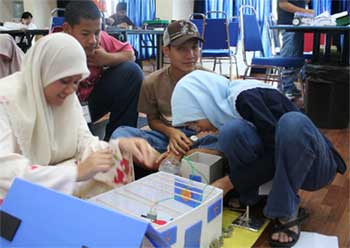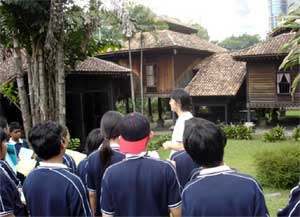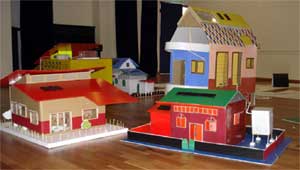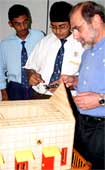Designing an Energy-Efficient Building
 Students build a prototype of their energy-efficient design at a SEED workshop in Malaysia, March 2006 |
For this project you will design a building that uses energy as efficiently as possible. Look at traditional buildings in your area for ideas on how to minimize energy use.
You should also try to make use of energy sources other than fossil fuels whenever possible. After designing the building you can build a model to prototype your ideas.
The strategies that you use should be specific to the climate and conditions where you live.
Step 1
Analyze the energy needs and sources for buildings in your area.
Describe general energy needs and sources.
|
Possible energy needs |
Possible energy sources |
|
Heating and/or cooling |
|
|
Interior lighting |
|
|
Heating water |
|
|
Storing food |
|
|
Cooking food |
|
|
Washing and/or drying clothes |
|
|
Small appliances |
|
|
Other |
 HOW NATURE DOES IT |
Step 2
Look at traditional buildings in your area.
We can learn a great deal from the way people constructed buildings in pre-industrial times. How did they provide for heating, cooling, cooking, food preservation and light before there were modern machines and appliances?
In the picture at the right, SEED students in Kuala Lumpur, Malaysia are visiting a restored house built in the early 20th Century. They learned about ways of keeping a house cool without air conditioning or electric fans.
Step 3
Select the type of building.
 There are many different types of buildings besides those where people live. Office buildings, concert halls, sports arenas, shopping malls, are all buildings with special purposes. All have energy needs. What type of building would you select for your project?
There are many different types of buildings besides those where people live. Office buildings, concert halls, sports arenas, shopping malls, are all buildings with special purposes. All have energy needs. What type of building would you select for your project?
Step 4
Design your building
Taking into account what you have learned about traditional buildings, design an energy efficient building of your own. But also include use of modern technology to improve energy efficiency.
There are several ways for a building to be energy-efficient. However, the key is to minimize the total energy use. This can be done with passive and active design elements. Passive elements would include building orientation and overhangs. Active elements would include motorized shutters and programmable thermostats.
You can use a GoGo Board to sense temperature and light conditions and then use that information to actively control components of your building to maximize energy efficiency.
Step 5
Build a prototype
 Build a working model based on your design. Decide on anappropriate scale. Choose materials. Build it.
Build a working model based on your design. Decide on anappropriate scale. Choose materials. Build it.
Energy efficient building projects at a SEED workshop in Malaysia in March 2006
Step 6
Test your prototype.

Test the active and passive design systems of your prototype building to see if they perform as you wish.Take data on the systems. Make any necessary revisions in your design.
Test … evaluate … modify …
This content has been re-published with permission from SEED. Copyright © 2025 Schlumberger Excellence in Education Development (SEED), Inc.
Course:

